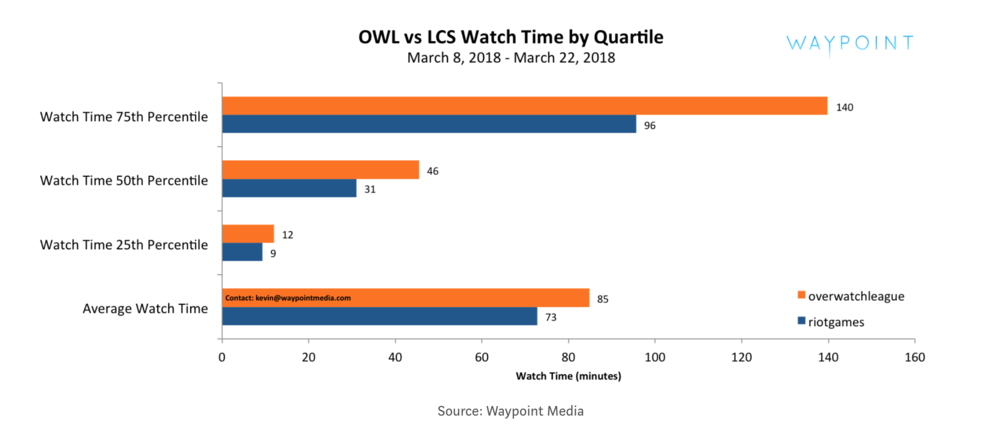Industry Guest Post: Kevin is the Chief Product Officer at Waypoint Media and in charge of all things data. Prior to Waypoint he was a Special Projects Engineer at General Atomics Aeronautical Systems and most recently worked on the AppNexus data science team building revenue optimization algorithms. He can be reached at [email protected].
Esports audiences are simple: they’re young, growing, and most importantly — engaged. Given the nature of esports this has generally been taken at face value, however as the industry matures, sophisticated marketers will be looking to validate these assumptions.
Third party publications report viewership with two specific metrics: average concurrent viewers and viewer hours. Eagle eyed observers however will recognize that these strictly measure quantity — the volume of content consumed.
To measure engagement the real question is: how long are viewers actually staying?
Case Study — Overwatch League vs LCS
The launch of Overwatch League (OWL) has surpassed all expectations. The inaugural season of the OWL has been keeping pace and at times even outperforming Riot’s League Championship Series (LCS).
JUST THE BASICS

From March 8th, 2018 to March 22nd, 2018 the classic metrics show that 20% more content was consumed on the OWL channel compared to the LCS, by broadcasting an extra 10 hours, and having 10% higher average concurrent viewers.
OWL looks marginally better here but there’s almost no information about actual audience behavior with the basic viewership metrics.
ENGAGEMENT DISTRIBUTION
To answer the question of audience behavior and to look deeper into viewing habits, Waypoint tracks near minute to minute channel viewership on over 82 million unique registered Twitch viewers.
With this we analyze what each viewer is watching and for how long. Aggregated across all broadcast we generate the engagement distribution.
Viewers are watching 48% longer on OWL compared to the LCS

Applying this analysis to the OWL and LCS we see exactly how the audience is behaving during each league’s broadcasts — the results are staggering. OWL blows LCS out of the water and it’s not even close.
At the 50th percentile, viewers are watching 48% longer on the OWL compared to the LCS. Possibly even more impressive, 25% of OWL viewers are watching for at least 2.3 hours per broadcast.
CONCLUSION
The basic viewership metrics average concurrent viewers and viewer hoursare woefully insufficient in describing a live esports broadcast. A broadcast’sengagement distribution describes how that channel is able to retain its viewership over time.
Comparing OWL and LCS’s basic viewership data, it’s hard to tell how each broadcast is performing. The engagement distribution clearly shows that Overwatch League is outperforming the LCS in viewer retention.
OWL is shiny and new, so it’s hard to say whether or not they’ll be able to keep it up, but what they’ve done up to this point is incredibly impressive.